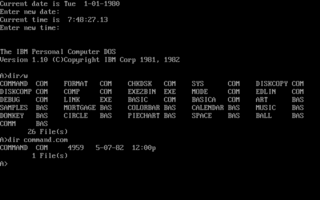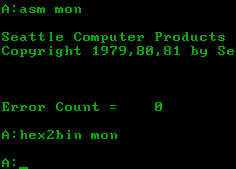File Allocation Table (FAT) is a file system developed for personal computers and was the default filesystem for MS-DOS and Windows 9x operating systems. Originally developed in 1977 for use on floppy disks, it was adapted for use on hard disks and other devices. The increase in disk drives capacity required three major variants: FAT12, FAT16 and FAT32. FAT was replaced with NTFS as the default file system on Microsoft operating systems starting with Windows XP. Nevertheless, FAT continues to be used on flash and other solid-state memory cards and modules, many portable and embedded devices because of its compatibility and ease of implementation.
A RAM drive is a block of random-access memory that a computer's software is treating as if the memory were a disk drive. RAM drives provide high-performance temporary storage for demanding tasks and protect non-volatile storage devices from wearing down, since RAM is not prone to wear from writing, unlike non-volatile flash memory. They are in a sense the reverse of virtual memory: RAM drive uses a volatile fast memory as if it's a nonvolatile slow memory. Virtual memory is the opposite.

IBM PC DOS, an acronym for IBM Personal Computer Disk Operating System, is a discontinued disk operating system for the IBM Personal Computer, its successors, and IBM PC compatibles. It was manufactured and sold by IBM from the early 1980s into the 2000s. Developed by Microsoft, it was also sold by that company as MS-DOS. Both operating systems were identical or almost identical until 1993, when IBM began selling PC DOS 6.1 with new features. The collective shorthand for PC DOS and MS-DOS was DOS, which is also the generic term for disk operating system, and is shared with dozens of disk operating systems called DOS.
Microsoft BASIC is the foundation software product of the Microsoft company and evolved into a line of BASIC interpreters and compiler(s) adapted for many different microcomputers. It first appeared in 1975 as Altair BASIC, which was the first version of BASIC published by Microsoft as well as the first high-level programming language available for the Altair 8800 microcomputer.

86-DOS is a discontinued operating system developed and marketed by Seattle Computer Products (SCP) for its Intel 8086-based computer kit.
Tim Paterson is an American computer programmer, best known for creating 86-DOS, an operating system for the Intel 8086. This system emulated the application programming interface (API) of CP/M, which was created by Gary Kildall. 86-DOS later formed the basis of MS-DOS, the most widely used personal computer operating system in the 1980s.

A bootloader, also spelled as boot loader or called bootstrap loader, is a computer program that is responsible for booting a computer. If it also provides an interactive menu with multiple boot choices then it's often called a boot manager.
A File Control Block (FCB) is a file system structure in which the state of an open file is maintained. A FCB is managed by the operating system, but it resides in the memory of the program that uses the file, not in operating system memory. This allows a process to have as many files open at one time as it wants, provided it can spare enough memory for an FCB per file.
IO.SYS is an essential part of MS-DOS and Windows 9x. It contains the default MS-DOS device drivers and the DOS initialization program.

IBMBIO.COM is a system file in many DOS operating systems. It contains the system initialization code and all built-in device drivers. It also loads the DOS kernel (IBMDOS.COM) and optional pre-loadable system components, displays boot menus, processes configuration files and launches the shell.
This article details versions of MS-DOS, IBM PC DOS, and at least partially compatible disk operating systems. It does not include the many other operating systems called "DOS" which are unrelated to IBM PC compatibles.
Undeletion is a feature for restoring computer files which have been removed from a file system by file deletion. Deleted data can be recovered on many file systems, but not all file systems provide an undeletion feature. Recovering data without an undeletion facility is usually called data recovery, rather than undeletion. Undeletion can both help prevent users from accidentally losing data, or can pose a computer security risk, since users may not be aware that deleted files remain accessible.

Charles Petzold is an American programmer and technical author on Microsoft Windows applications. He is also a Microsoft Most Valuable Professional and was named one of Microsoft's seven Windows Pioneers.
MSX-DOS is a discontinued disk operating system developed by Microsoft's Japan subsidiary for the 8-bit home computer standard MSX, and is a cross between MS-DOS v1.25 and CP/M-80 v2.2.
In computing, sys is a command used in many operating system command-line shells and also in Microsoft BASIC.
The DOS API is an API which originated with 86-DOS and is used in MS-DOS/PC DOS and other DOS-compatible operating systems. Most calls to the DOS API are invoked using software interrupt 21h. By calling INT 21h with a subfunction number in the AH processor register and other parameters in other registers, various DOS services can be invoked. These include handling keyboard input, video output, disk file access, program execution, memory allocation, and various other activities. In the late 1980s, DOS extenders along with the DOS Protected Mode Interface (DPMI) allow the programs to run in either 16-bit or 32-bit protected mode and still have access to the DOS API.

MS-DOS is an operating system for x86-based personal computers mostly developed by Microsoft. Collectively, MS-DOS, its rebranding as IBM PC DOS, and a few operating systems attempting to be compatible with MS-DOS, are sometimes referred to as "DOS". MS-DOS was the main operating system for IBM PC compatibles during the 1980s, from which point it was gradually superseded by operating systems offering a graphical user interface (GUI), in various generations of the graphical Microsoft Windows operating system.

DOS is a family of disk-based operating systems for IBM PC compatible computers. The DOS family primarily consists of IBM PC DOS and a rebranded version, Microsoft's MS-DOS, both of which were introduced in 1981. Later compatible systems from other manufacturers include DR-DOS (1988), ROM-DOS (1989), PTS-DOS (1993), and FreeDOS (1998). MS-DOS dominated the IBM PC compatible market between 1981 and 1995.
The FAT file system is a file system used on MS-DOS and Windows 9x family of operating systems. It continues to be used on mobile devices and embedded systems, and thus is a well suited file system for data exchange between computers and devices of almost any type and age from 1981 through the present.






